Ornamental flowering shrubs are ideal for decorating a garden plot. With the help of luxurious shoots, it is possible to hide not the most beautiful corners of the garden or to decorate the facade of the house. Summer residents or owners of personal plots of the southern regions can safely plant a shrub, spending a minimum of effort to care for it. However, the landing and care of rhododendrons in the suburbs has a number of its own characteristics.
Material Content:
The nuances of growing rhododendrons in the suburbs
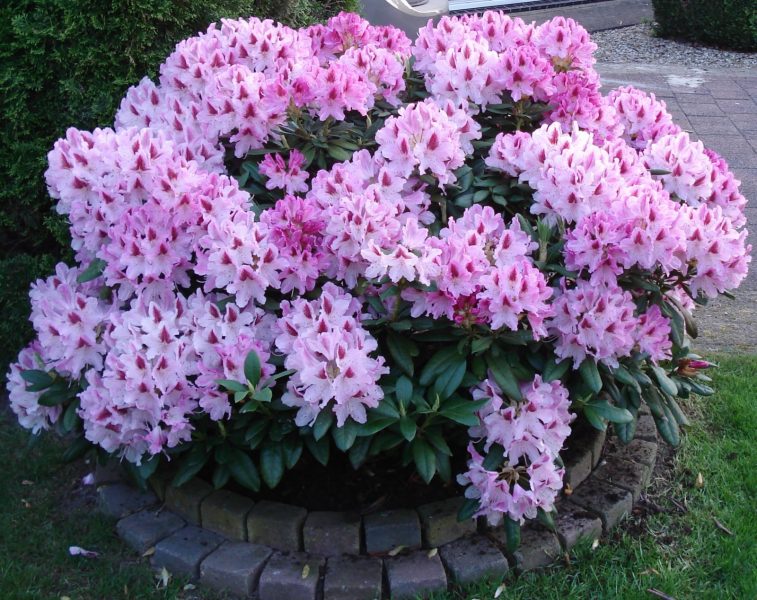
Growing rosewood in the Middle Strip has a number of subtleties. There are a large number of species in the culture, but not everyone can withstand the harsh climate of the Moscow Region - significant differences in daily and seasonal temperatures, uneven rainfall, return frosts in spring and early onset of cold weather in autumn. In the zone of risky farming, to which the Moscow region is assigned due to climatic features, a competent approach to plant cultivation is required, starting with the correct selection of seedlings of the Asian representative.
Suitable plant species and varieties
The most commonly used species in temperate continental regions are frost-resistant rhododendrons, but this is not the only characteristic to choose from.
Rhododendron Ledebour
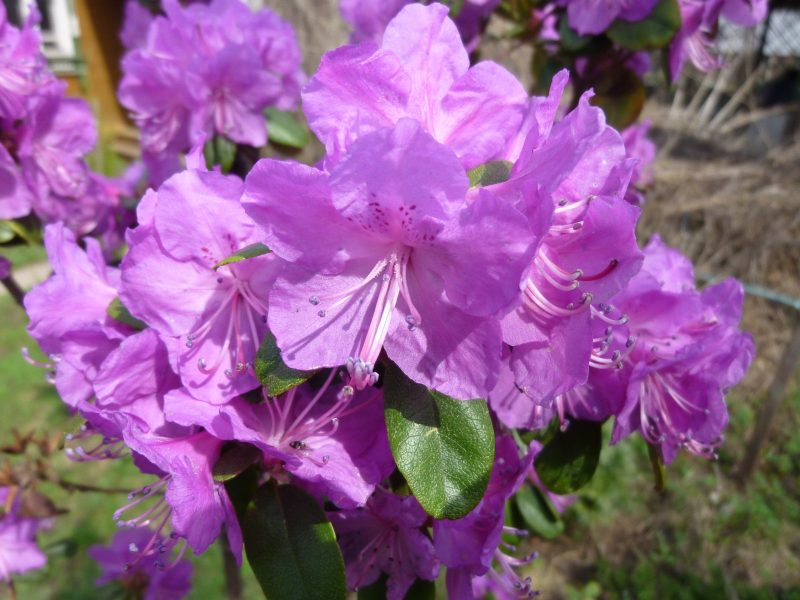
He is a maralnik - a semi-evergreen shrub whose height ranges from half a meter to two. Small glossy leaves covered with a fringe winter on the shoots, and are renewed after flowering, which occurs twice during the growing season - in May and September. Asymmetric bell-shaped pink flowers are collected in racemose inflorescences. The view can withstand lowering the thermometer to -32⁰C.
Rhododendron Daursky
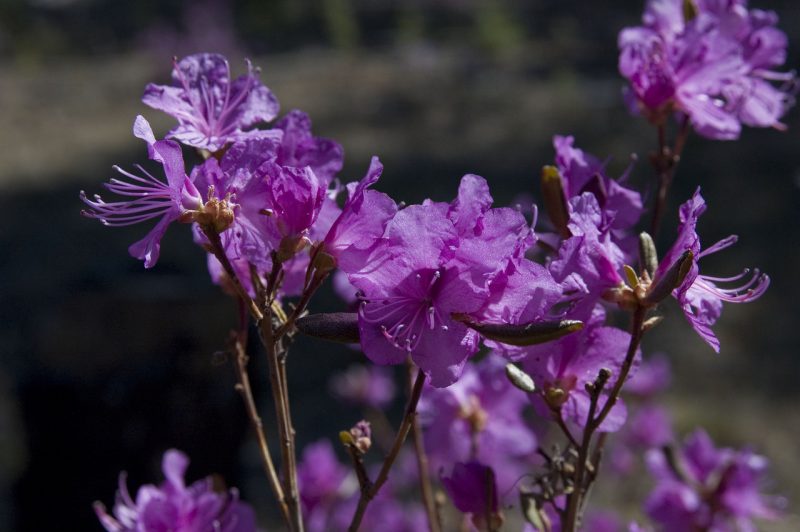
Known as Ledum and looks very similar to the previous look, but the foliage falls after the arrival of autumn. Most attractive from mid-spring to mid-summer. The flowering phase lasts 20 days when the light pink bell-shaped flowers with a purple tint bloom. The botanical species is much more resistant to frost than cultivars.
Rhododendron Katevbinsky
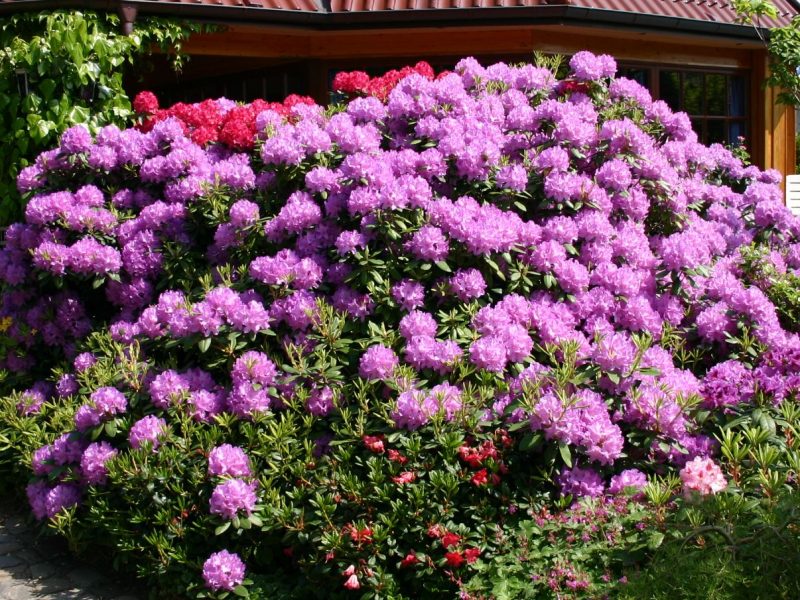
The height of the species with an average duration of 100 years can reach 4 m. Large shiny leaves up to 15 cm in length, painted in dark green with prominent veins and a pale underside, have an elliptical shape. It blooms in late spring or early summer with white or lilac flowers, sometimes interspersed with green. The most popular varieties are Album, Boursault, Grandiflorum, Nova Zembla, Alfred.
Rhododendron Smirnova
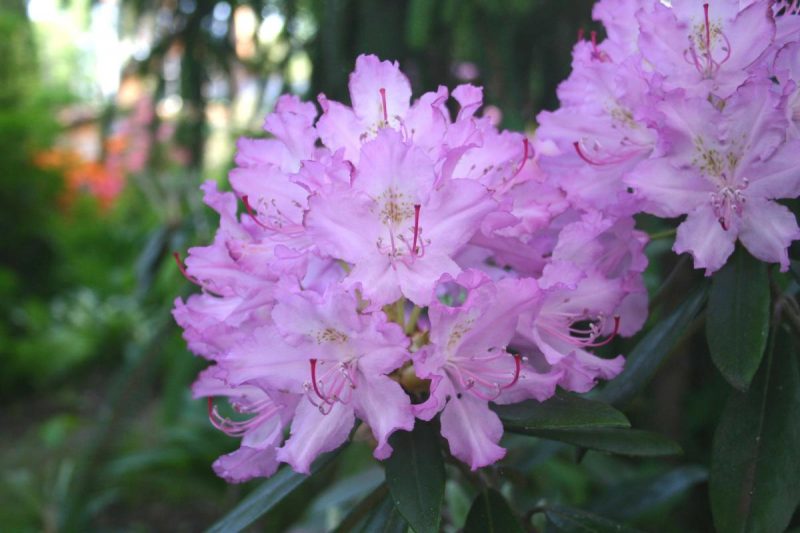
1.5 m tall evergreen shrub native to Turkey. Large oblong elliptical plates reach 15 cm in length and 4 cm in width. The purple-pink petals of flowers collected in a dense inflorescence are strewn with yellow dots. Based on the variety, cold-resistant varieties were developed: Dorothy, Laika, and Gabriel.
Rhododendron Kashkara

A slow-growing inhabitant of Siberia and the Far East, half a meter high, is able to form impenetrable thickets. Evergreen foliage is very dense. Yellow flowers collected in umbrella inflorescences are noted at the beginning of the summer season. Resistant to frost at -26⁰C.
Important! In gardens and flower beds, the view is very poorly taken root.
Schlippenbach Rhododendron
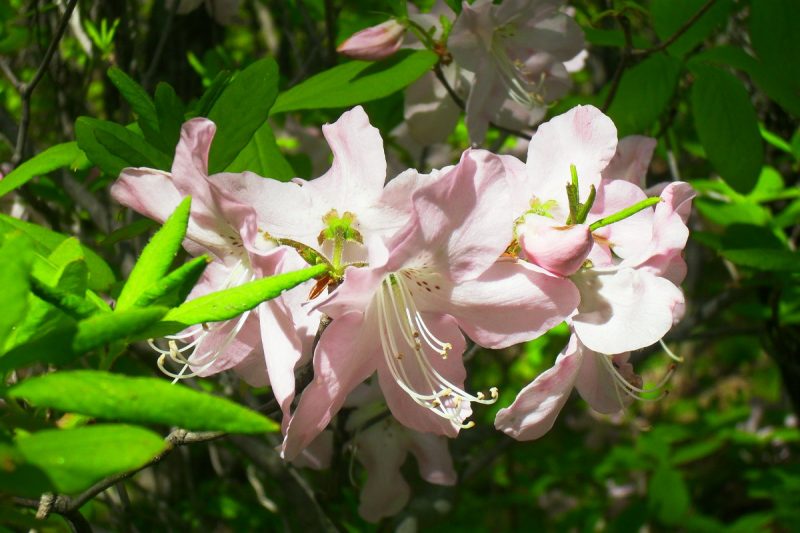
A beautiful deciduous variety with spreading shoots up to 2 m high, covered with small leafy plates and large flowers of 8 cm. Fragrant pink or white flowers form inflorescences in early May.
Rhododendron Canadian
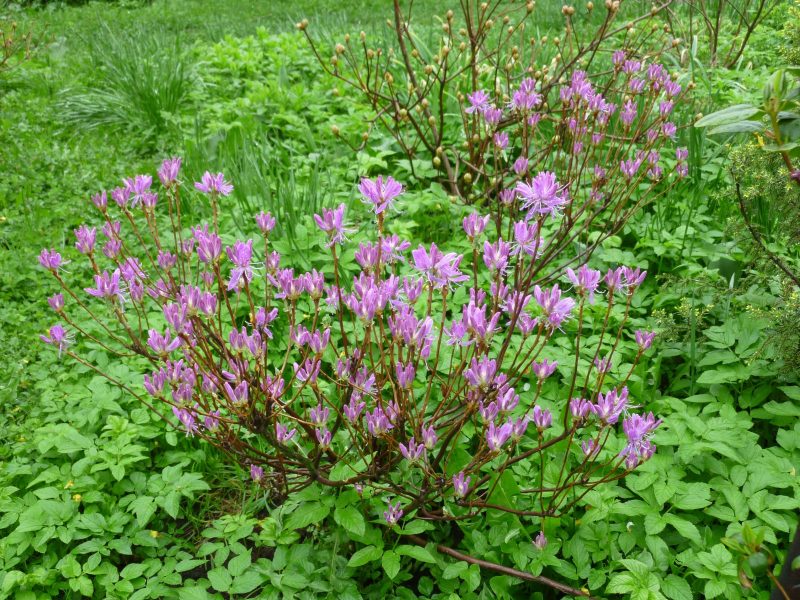
The undersized bush, not exceeding a meter, is a native of the North American region. Greenish-blue sheets of medium size densely cover the shoots. Flavourless pink-violet flowers are collected in corymbose inflorescences.
Rhododendron Japanese
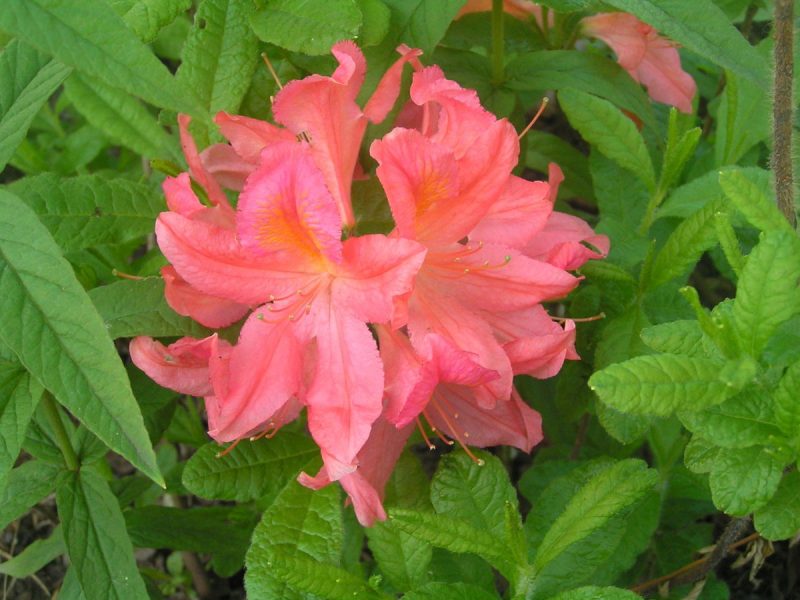
The Asian representative is used in Central Russia as the most decorative species, combining unpretentiousness and frost resistance. As a rule, it reaches one and a half meters in height and is distinguished by lush flowering from the end of spring, which lasts for a month. Bell-shaped corollas of red flowers with yellow splashes are collected in lush inflorescences.
Rhododendron

The evergreen bush from Asia has the largest height of 6 m and large leathery leafy plates. Thyroid inflorescences consist of 15 flowers of pink or white. Flowering occurs in July after the plant reaches the age of 18-20 years.
Outdoor landing
To grow a rosewood and get bright flowers and its natural attractiveness, you will need to make efforts to properly organize planting, choosing the right place.
Preparing the place and soil for planting
In order to minimize plant stress, a place for an exotic representative is selected taking into account its natural growth environment.
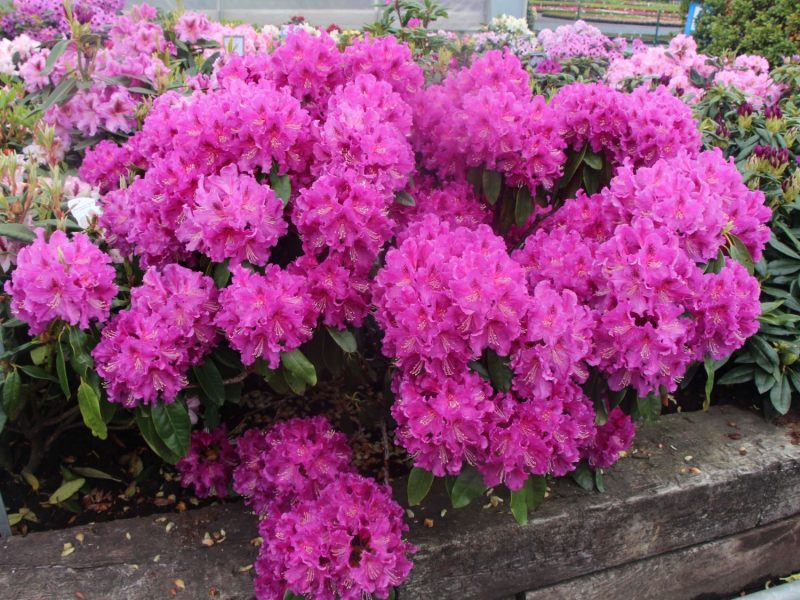
Characteristics of the optimal location of the plant:
- A plot of northern direction that is shaded during the day.
- The absence of buildings from the roofs of which snow can fall on the plant.
- Deep occurrence of groundwater.
- The absence of drafts, which can cause a minimum amount of snow cover, which acts as a protection against frost.
Under natural conditions, rhododendrons often develop in the shade of trees, which makes planting possible by analogy in the garden.But neighboring trees must have a rooted root system that goes deeper - pine, apple, larch, pear, cherry, oak. If there are birch, linden or alder with a fibrous root system located at the same level as that of a rosewood, this can lead to the death of both plants due to a lack of nutrition and space.
To ensure normal growth, the shrub requires an acidity of 4.5-5.5. In case of less acidity, a loose and light substrate of loam, acid peat and pine litter in equal parts is used for planting.
Attention! When replacing loam with clay, components such as humus, manure, sawdust, ash and chernozem are added to the soil mixture.
How and when to plant rhododendron correctly?
Landing will take place without difficulty, if you use the following algorithm:
- At the prepared site, a 60x60 landing pit is excavated with a depth of 40 cm.
- The bottom is lined with a 20 cm drainage layer of broken brick or expanded clay.
- Part of the pit is filled with a substrate so that the root neck is at ground level.
- A sapling with straightened roots is placed on a compacted soil mixture.
- The hole is completely covered with a substrate, which is finally compacted.
- The near-trunk zone is abundantly watered and mulched with peat, needles or leafy earth.
- If necessary, a temporary support is installed.
Important! Rhododendron is planted throughout the growing season except for the flowering phase. But early spring is the best time.
Care in the suburbs
When planting a rosewood in compliance with agrotechnical requirements, care will not take much effort and time.
Watering
Exotic shrubs require frequent, but not plentiful, irrigation with standing water, to soften which a few handfuls of peat are added the day before the procedure. The soil should be saturated with water for 25 cm. Deficiency of moisture leads to inhibition of the plant, in which drooping foliage is observed, losing its luster. With the advent of autumn, watering is minimized so that the bush stops active growth and begins to prepare for wintering.
Attention! In the conditions of the Moscow Region, a dry autumn is possible, in which watering is carried out in small portions.
Top dressing
Feeding of rosewood is carried out until the end of June twice a month. The shrub is fertilized with mineral complexes purchased in specialized stores according to the instructions on the package or with superphosphate and nitroammophos with a spread rate of 50 g per 1 m2.
Important! Fertilizing is not allowed from the beginning of July, otherwise the plant will build up green mass instead of preparing for winter.
How to prune rhododendron?
Rhododendron practically does not need pruning, forming the correct crown on its own. The plant is cut for sanitary and anti-aging purposes before the juice starts to move: damaged shoots are removed and half of the branches are shortened to rejuvenate to 40 cm. If you want to have a shrub with a more compact crown, a correct cut is carried out after flowering.
Features of care in the fall, preparation for winter
Caring for rhododendron in the fall is to take measures to protect the shoots from freezing during severe frosts. When the first frosts of the branch pass between which the spruce is placed, they are pulled together with twine. The shrub turns into covering material, which is removed in the spring after the snow melts.
Diseases and Pests
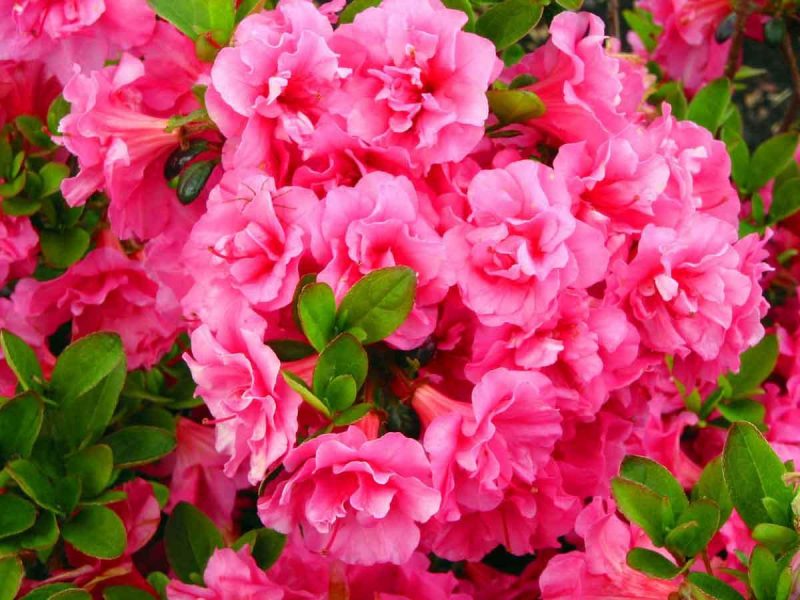
The culture is considered resistant to diseases, among which the most common are rot and spotting. To combat such fungal diseases, Bordeaux liquid or another copper-containing preparation is treated. Of the pests on the rhododendron there are aphids, spider mites, slugs, and insects. As a protective measure, spraying with the insecticide Actellik, Confidor or another analogue is organized according to the manufacturer's instructions.
Plant propagation
Growing rhododendrons is possible both from seeds and using the vegetative method of reproduction.
- Seed method. In harsh winters, the generative breeding method is time-consuming, unproductive and rarely used.
- Cuttings. Also a rather complicated technique, in which the rooting of cuttings cut from half-lignified shoots occurs within 4 months in greenhouse conditions. In the open ground, seedlings obtained in this way are planted only after 2 years.
- Reproduction by layering. Ideal for rosewood. With the advent of spring, young shoots are dug into grooves up to 15 cm deep, and the top is tied up vertically. In the fall or next spring, cuttings are separated and transplanted to a permanent place.
So, subject to agricultural practices for planting and care, an exotic shrub is able to fully develop in the climatic conditions of the Moscow Region and give a lot of positive to its owners.












